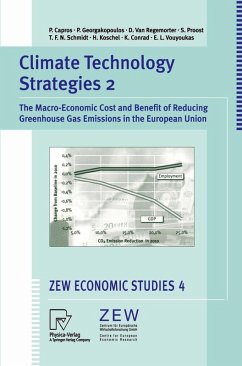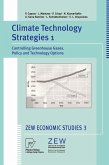Pantelis Capros, Panagiotis Georgakopoulos, Denise Van Regemorter, Stef Proost, Tobias F. N. Schmidt, Henrike Koschel, Klaus Conrad, E. Lakis Vouyoukas
Climate Technology Strategies 2 (eBook, PDF)
The Macro-Economic Cost and Benefit of Reducing Greenhouse Gas Emissions in the European Union
40,95 €
40,95 €
inkl. MwSt.
Sofort per Download lieferbar

20 °P sammeln
40,95 €
Als Download kaufen

40,95 €
inkl. MwSt.
Sofort per Download lieferbar

20 °P sammeln
Jetzt verschenken
Alle Infos zum eBook verschenken
40,95 €
inkl. MwSt.
Sofort per Download lieferbar
Alle Infos zum eBook verschenken

20 °P sammeln
Pantelis Capros, Panagiotis Georgakopoulos, Denise Van Regemorter, Stef Proost, Tobias F. N. Schmidt, Henrike Koschel, Klaus Conrad, E. Lakis Vouyoukas
Climate Technology Strategies 2 (eBook, PDF)
The Macro-Economic Cost and Benefit of Reducing Greenhouse Gas Emissions in the European Union
- Format: PDF
- Merkliste
- Auf die Merkliste
- Bewerten Bewerten
- Teilen
- Produkt teilen
- Produkterinnerung
- Produkterinnerung

Bitte loggen Sie sich zunächst in Ihr Kundenkonto ein oder registrieren Sie sich bei
bücher.de, um das eBook-Abo tolino select nutzen zu können.
Hier können Sie sich einloggen
Hier können Sie sich einloggen
Sie sind bereits eingeloggt. Klicken Sie auf 2. tolino select Abo, um fortzufahren.

Bitte loggen Sie sich zunächst in Ihr Kundenkonto ein oder registrieren Sie sich bei bücher.de, um das eBook-Abo tolino select nutzen zu können.
Climate technology becomes more and more relevant in international environmental policy negotiations. At the Kyoto conference binding emission reduction targets have been established for several regions of the world. The major challenge is how to realize these reduction goals with minimum costs without generating new distributional and social difficulties. The book analyses the macroeconomic structural and distributional impacts of greenhouse gas mitigation strategies for the EU and the member states.
- Geräte: PC
- ohne Kopierschutz
- eBook Hilfe
- Größe: 25.84MB
Andere Kunden interessierten sich auch für
![Climate Technology Strategies 1 (eBook, PDF) Climate Technology Strategies 1 (eBook, PDF)]() Pantelis CaprosClimate Technology Strategies 1 (eBook, PDF)73,95 €
Pantelis CaprosClimate Technology Strategies 1 (eBook, PDF)73,95 €- -23%11
![Man-Made Climate Change (eBook, PDF) Man-Made Climate Change (eBook, PDF)]() Man-Made Climate Change (eBook, PDF)40,95 €
Man-Made Climate Change (eBook, PDF)40,95 € ![Emissions Trading and Business (eBook, PDF) Emissions Trading and Business (eBook, PDF)]() Emissions Trading and Business (eBook, PDF)73,95 €
Emissions Trading and Business (eBook, PDF)73,95 €![Economic Instruments for Air Pollution Control (eBook, PDF) Economic Instruments for Air Pollution Control (eBook, PDF)]() Economic Instruments for Air Pollution Control (eBook, PDF)73,95 €
Economic Instruments for Air Pollution Control (eBook, PDF)73,95 €![Environmental Change and Security (eBook, PDF) Environmental Change and Security (eBook, PDF)]() Environmental Change and Security (eBook, PDF)40,95 €
Environmental Change and Security (eBook, PDF)40,95 €- -22%11
![Ökonomische Aspekte internationaler Klimapolitik (eBook, PDF) Ökonomische Aspekte internationaler Klimapolitik (eBook, PDF)]() Wolfgang BräuerÖkonomische Aspekte internationaler Klimapolitik (eBook, PDF)42,99 €
Wolfgang BräuerÖkonomische Aspekte internationaler Klimapolitik (eBook, PDF)42,99 € ![Road Pricing, the Economy and the Environment (eBook, PDF) Road Pricing, the Economy and the Environment (eBook, PDF)]() Road Pricing, the Economy and the Environment (eBook, PDF)113,95 €
Road Pricing, the Economy and the Environment (eBook, PDF)113,95 €-
-
-
Climate technology becomes more and more relevant in international environmental policy negotiations. At the Kyoto conference binding emission reduction targets have been established for several regions of the world. The major challenge is how to realize these reduction goals with minimum costs without generating new distributional and social difficulties. The book analyses the macroeconomic structural and distributional impacts of greenhouse gas mitigation strategies for the EU and the member states.
Dieser Download kann aus rechtlichen Gründen nur mit Rechnungsadresse in A, B, BG, CY, CZ, D, DK, EW, E, FIN, F, GR, HR, H, IRL, I, LT, L, LR, M, NL, PL, P, R, S, SLO, SK ausgeliefert werden.
Produktdetails
- Produktdetails
- Verlag: Physica-Verlag HD
- Seitenzahl: 224
- Erscheinungstermin: 6. Dezember 2012
- Englisch
- ISBN-13: 9783642586903
- Artikelnr.: 53149127
- Verlag: Physica-Verlag HD
- Seitenzahl: 224
- Erscheinungstermin: 6. Dezember 2012
- Englisch
- ISBN-13: 9783642586903
- Artikelnr.: 53149127
- Herstellerkennzeichnung Die Herstellerinformationen sind derzeit nicht verfügbar.
1 Introduction.- 1.1 The Economic Cost of CO2 Abatement.- 1.2 Structure of the Volume.- 2 Literature Review.- 2.1 Introduction.- 2.2 Models and Studies for the Cost of Ghg Abatement.- 2.3 Gaps From Previous Studies and Directions of Future Research.- 3 Definition Of Policy Instruments And Criteria For Their Assessment.- 3.1 Introduction.- 3.2 Criteria for the Assessment of Environmental Policy Instruments.- 3.3 Selected Environmental Policy Instruments.- 3.4 Evaluation of Environmental Policy Instruments.- 3.5 Conclusions.- 4 Baseline Scenario for the Eu and Overview of Policy Simulations.- 4.1 Introduction.- 4.2 The Baseline Scenario: The European Economy To 2010.- 4.3 Environmental Constraints in The Gem-E3 Model: An Overview of the Model Mechanisms.- 4.4 Definition of the Policy Scenarios.- 5 The Cost of Meeting Emission Reduction Targets: Pollution Permits.- 6 The Role of Accompanying Policies.- 6.1 Recycling Through the Reduction of Labour Costs.- 6.2 Recycling Through the Reduction Of Investment Costs.- 6.3 No Recycling.- 7 The Role of Energy Saving Investment.- 7.1 Model Specification.- 7.2 Simulation Results.- 8 Internalisation of Externalities.- 8.1 Introduction.- 8.2 Methodology.- 8.3 The Externalities and Their Damage Valuation.- 8.4 The Internalisation Scenario.- 8.5 Simulation Results.- 9 Burden Sharing.- 9.1 Introduction.- 9.2 Equity and Efficiency.- 9.3 Operationalisation of Equity Rules.- 9.4 The Burden Sharing Issue in the Eu Context.- 9.5 Simulation of an Eu Wide Permit Scheme Under Alternative Equity Rules.- 9.6 Conclusion.- 10 Sensitivity Analysis.- 10.1 Labour Market Rigidities and the Double Dividend Issue.- 10.2 World Context.- 11 Conclusions.- 11.1 Emission Abatement and Sustainable Development.- 11.2 Policy Instruments.- 11.3 Policy Evaluation Criteria and Main Results.- 12 Appendix: Brief Description of Models Used in the Study.- 12.1 GEM-E3.- List of Figures.- List of Tables.- References.
1 Introduction.- 1.1 The Economic Cost of CO2 Abatement.- 1.2 Structure of the Volume.- 2 Literature Review.- 2.1 Introduction.- 2.2 Models and Studies for the Cost of Ghg Abatement.- 2.3 Gaps From Previous Studies and Directions of Future Research.- 3 Definition Of Policy Instruments And Criteria For Their Assessment.- 3.1 Introduction.- 3.2 Criteria for the Assessment of Environmental Policy Instruments.- 3.3 Selected Environmental Policy Instruments.- 3.4 Evaluation of Environmental Policy Instruments.- 3.5 Conclusions.- 4 Baseline Scenario for the Eu and Overview of Policy Simulations.- 4.1 Introduction.- 4.2 The Baseline Scenario: The European Economy To 2010.- 4.3 Environmental Constraints in The Gem-E3 Model: An Overview of the Model Mechanisms.- 4.4 Definition of the Policy Scenarios.- 5 The Cost of Meeting Emission Reduction Targets: Pollution Permits.- 6 The Role of Accompanying Policies.- 6.1 Recycling Through the Reduction of Labour Costs.- 6.2 Recycling Through the Reduction Of Investment Costs.- 6.3 No Recycling.- 7 The Role of Energy Saving Investment.- 7.1 Model Specification.- 7.2 Simulation Results.- 8 Internalisation of Externalities.- 8.1 Introduction.- 8.2 Methodology.- 8.3 The Externalities and Their Damage Valuation.- 8.4 The Internalisation Scenario.- 8.5 Simulation Results.- 9 Burden Sharing.- 9.1 Introduction.- 9.2 Equity and Efficiency.- 9.3 Operationalisation of Equity Rules.- 9.4 The Burden Sharing Issue in the Eu Context.- 9.5 Simulation of an Eu Wide Permit Scheme Under Alternative Equity Rules.- 9.6 Conclusion.- 10 Sensitivity Analysis.- 10.1 Labour Market Rigidities and the Double Dividend Issue.- 10.2 World Context.- 11 Conclusions.- 11.1 Emission Abatement and Sustainable Development.- 11.2 Policy Instruments.- 11.3 Policy Evaluation Criteria and Main Results.- 12 Appendix: Brief Description of Models Used in the Study.- 12.1 GEM-E3.- List of Figures.- List of Tables.- References.







